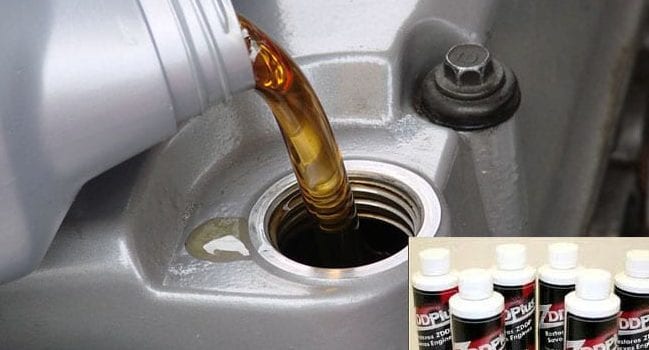
For most vintage or collector car owners, do-it-yourself maintenance is a point of pride. If you’ve put years of blood, sweat and tears into your collectible, the last thing you want is for a complete stranger to lay their greasy hands all over your baby. So you change the oil yourself. But is there an issue with zinc dialkyldithiophosphate or ZDDP – or more precisely, has its absence put vintage car engines at risk?
 Oil. When it comes time for a change, most of us just wheel into the nearest lube joint or dealership and get it done by someone else.
Oil. When it comes time for a change, most of us just wheel into the nearest lube joint or dealership and get it done by someone else.
The do-it-yourselfer who breaks out the tool kit, jacks up the front end, rolls up their sleeves and changes their own oil is becoming something of an endangered species.
And many of today’s cars are so precise in their lubrication requirements, it’s better to leave it to an expert. In some cases, you can void your warranty and/or scramble the car’s computer by putting in the wrong engine oil.
Not so the vintage or collector car owner. For most of us, do-it-yourself maintenance is a point of pride. If you’ve put years of blood, sweat and tears into your collectible, the last thing you want is for a complete stranger to lay their greasy hands all over your baby.
For DIYers, changing oil at least twice a year is something of a ritual and most collector car buffs just do it as matter of course. Pick the best oil you can, change the filter while you’re at it and Bob’s your uncle.
But there’s a bit of a fly in the ointment: one of the active ingredients in engine oil – zinc dialkyldithiophosphate or ZDDP – has been found to hasten the demise of catalytic converters in many automobiles.
So a few years ago, oil manufacturers began to slowly diminish the ZDDP content in their products to the point where now, varieties such as Castrol GTX (a favourite with British car lovers) have almost none.
This may be good for the environment but the downside is that ZDDP protects things like camshafts, piston rings and lifters, and some restorers reported experiencing catastrophic engine failures after changing to oil with no ZDDP. The Internet was abuzz with horror stories, death threats and tales of woe.
But like so many things on the web (ever tried to self-diagnose a medical condition on the Internet?), there was more to this than met the eye.
Yes, lack of ZDDP could damage a freshly-rebuilt engine. But in nine cases out of 10, it made no difference whatsoever.
Apparently, a crop of bad engine components made offshore didn’t help things in the hobby car community. But compared to the oil that was being produced 50 years ago, today’s lubricant is light years better than it used to be. In the 1950s, for example, everybody used non-detergent 30-weight and ZDDP didn’t even exist. Our family car when I was growing up was a made-in-Oshawa 1956 Pontiac station wagon that didn’t even have an oil filter.
However, if you have a hot engine with a really aggressive cam and high-performance internals, you probably shouldn’t use oil that you buy at your local discount store. These kinds of engines should use an oil designed for racing.
The same is true of freshly rebuilt engines. For the first couple of thousand kilometres, during the break-in period, a high-performance oil with zinc and phosphorous content should be used. Royal Purple makes such a product, as do manufacturers such as Valvoline, Duckhams, Kendall and on and on.
So how to tell if the oil you’re purchasing has ZDDP in it?
On the back of the oil container, you should find a small circle with the weight of the oil and an American Petroleum Institute (API) service rating within it. If the oil is rated SM, SN or SP, it will likely have a low ZDDP content.
For any car with a catalytic converter, this presents no problem. For oldsters, you should be OK as well, as long as the car has a few kilometres on it. What you’re looking for is an API rating of SL or SJ or lower – if you can find one.
You can also buy ZDDP additives that you can add to the oil when you change it. ACDelco, for example, makes one. That said, today’s breed of engine oil is made to a precise formula and if you change that, you change the oil’s effectiveness.
So the moral of the story is: don’t believe everything you read on the Internet.
Except this, of course.
Ted Laturnus writes for Troy Media’s Driver Seat Associate website. An automotive journalist since 1976, he has been named Canadian Automotive Journalist of the Year twice and is past-president of the Automotive Journalists Association of Canada (AJAC).
The views, opinions and positions expressed by columnists and contributors are the author’s alone. They do not inherently or expressly reflect the views, opinions and/or positions of our publication.

